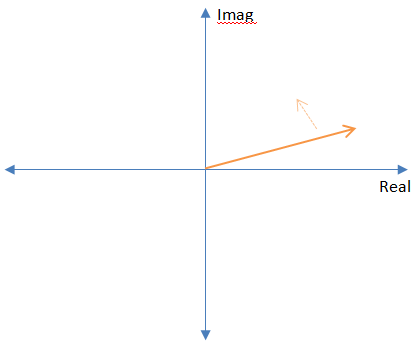i would just say that the original convention is to represent complex sinusoids with a positive exponent. so a voltage "phasor" would be
$$ v(t) = V e^{j \omega t} $$
($V$ is a complex constant, and $|V|$ represents the magnitude of the phasor and $\arg\{V\}$ represents the phase of the phasor.) i s'pose we could define the convention as
$$ v(t) = V e^{-j \omega t} $$
but my question would be "why bother?"
why a complex exponential? because $e^{s t}$ is an eigenfunction (essentially the eigenfunction) of linear time-invariant (LTI) systems, which are what we apply Fourier and Laplace transforms to. when $e^{s t}$ goes into an LTI system, something times $e^{s t}$ comes out.
LTI systems can be completely described by, or have their input/output relationship completely described by their impulse response $h(t)$. that description is convolution:
$$ y(t) = \int\limits_{-\infty}^{\infty} h(\tau) x(t-\tau) \ d \tau $$
if the input is
$$ x(t) = e^{s t}$$
the output is
$$ \begin{align}
y(t) & = \int\limits_{-\infty}^{\infty} h(\tau) x(t-\tau) \ d \tau \\
& = \int\limits_{-\infty}^{\infty} h(\tau) e^{s (t-\tau)} \ d \tau \\
& = \int\limits_{-\infty}^{\infty} h(\tau) e^{-s \tau} \ d \tau \ \ e^{s t} \\
& = H(s) \ e^{s t} \\
& = H(s) \ x(t) \\
\end{align} $$
so $x(t)=e^{s t}$ is an eigenfunction and the eigenvalue, the thing that scales the eigenfunction in an LTI system is $H(s)$ and directly related to $h(t)$.
then the rest is all about Fourier. so Fourier generalizes a little, first with a periodic $x(t)$ that Fourier posits that can be represented with sinusoids all having the same period as $x(t)$.
$$ x(t+T) = x(t) \quad \forall t $$
$$ x(t) = \sum\limits_{k=-\infty}^{\infty} X[k] \ e^{j \frac{2 \pi k}{T} t} $$
it's still the original convention: define the signal as a phasor $e^{j \omega t}$. the positive exponent remains. $X[k]$ are the "Fourier coefficients".
so we know that the output is
$$ \begin{align}
y(t) & = \sum\limits_{k=-\infty}^{\infty} H\left(j \frac{2 \pi k}{T} \right) X[k] \ e^{j \frac{2 \pi k}{T} t} \\
& = \sum\limits_{k=-\infty}^{\infty} Y[k] \ e^{j \frac{2 \pi k}{T} t} \\
\end{align} $$
another periodic function, having the same period, but with different Fourier coefficients.
so, positive $\omega$ in the exponent.
so what are those Fourier coefficients?
$$ \begin{align}
\int\limits_{0}^{T} x(t) e^{-j \frac{2 \pi m}{T} t} \ dt & = \int\limits_{0}^{T} x(t) e^{-j \frac{2 \pi m}{T} t} \ dt \\
& = \int\limits_{0}^{T} \sum\limits_{k=-\infty}^{\infty} X[k] e^{j \frac{2 \pi k}{T} t} e^{-j \frac{2 \pi m}{T} t} \ dt \\
& = \int\limits_{0}^{T} \sum\limits_{k=-\infty}^{\infty} X[k] e^{j \frac{2 \pi (k-m)}{T} t} \ dt \\
& = \sum\limits_{k=-\infty}^{\infty} X[k] \int\limits_{0}^{T} e^{j \frac{2 \pi (k-m)}{T} t} \ dt \\
\end{align} $$
for every $k$ in the sum where $k \ne m$, the integral is zero so the term in the summation is zero.
$$ \int\limits_{0}^{T} e^{j \frac{2 \pi (k-m)}{T} t} \ dt =
\begin{cases}
0, & \text{for } k \ne m \\
T, & \text{for } k = m
\end{cases} $$
for the single non-zero term, when $k=m$, we have
$$ \int\limits_{0}^{T} x(t) e^{-j \frac{2 \pi m}{T} t} \ dt = X[m] T $$
so
$$ X[m] = \frac{1}{T} \ \int\limits_{0}^{T} x(t) e^{-j \frac{2 \pi m}{T} t} \ dt $$
that is where the negative exponent comes from. we need that exponent to be negative so that only the $m^{\text{th}}$ term in the summation survives (when $k=m$ and $e^{j \frac{2 \pi (k-m)}{T} t}=1$), thus isolating a single $X[m]$ so we know what it is. otherwise it would be the $-m^{\text{th}}$ term surviving and we would have to change the convention in our original definition of $x(t)$.
this remains essentially the case as the Fourier series representation is generalized to non-periodic $x(t)$, where the summation becomes an integral. because we define our signal as a sort of integral summation of these exponential (with positive exponents) eigenfunctions:
$$ x(t) = \frac{1}{2 \pi} \int\limits_{-\infty}^{\infty} X(j \omega) e^{j \omega t} \ d \omega $$
again, to get those Fourier "coefficients", we need a negative exponent:
$$ X(j \omega) = \int\limits_{-\infty}^{\infty} x(t) e^{-j \omega t} dt $$
Laplace generalizes further by allowing that purely imaginary value $j \omega$ to be a more general complex value, $s = \sigma + j \omega$. but that does not change the sign convention.



